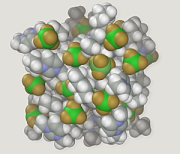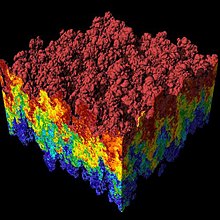
Computational chemistry is a branch of chemistry that uses computer simulations to assist in solving chemical problems. It uses methods of theoretical chemistry incorporated into computer programs to calculate the structures and properties of molecules, groups of molecules, and solids. The importance of this subject stems from the fact that, with the exception of some relatively recent findings related to the hydrogen molecular ion, achieving an accurate quantum mechanical depiction of chemical systems analytically, or in a closed form, is not feasible. The complexity inherent in the many-body problem exacerbates the challenge of providing detailed descriptions of quantum mechanical systems. While computational results normally complement information obtained by chemical experiments, it can occasionally predict unobserved chemical phenomena.
Mechanosynthesis is a term for hypothetical chemical syntheses in which reaction outcomes are determined by the use of mechanical constraints to direct reactive molecules to specific molecular sites. There are presently no non-biological chemical syntheses which achieve this aim. Some atomic placement has been achieved with scanning tunnelling microscopes.

MOLPRO is a software package used for accurate ab initio quantum chemistry calculations. It is developed by Peter Knowles at Cardiff University and Hans-Joachim Werner at Universität Stuttgart in collaboration with other authors.
Q-Chem is a general-purpose electronic structure package featuring a variety of established and new methods implemented using innovative algorithms that enable fast calculations of large systems on various computer architectures, from laptops and regular lab workstations to midsize clusters, HPCC, and cloud computing using density functional and wave-function based approaches. It offers an integrated graphical interface and input generator; a large selection of functionals and correlation methods, including methods for electronically excited states and open-shell systems; solvation models; and wave-function analysis tools. In addition to serving the computational chemistry community, Q-Chem also provides a versatile code development platform.

SIESTA is an original method and its computer program implementation, to efficiently perform electronic structure calculations and ab initio molecular dynamics simulations of molecules and solids. SIESTA uses strictly localized basis sets and the implementation of linear-scaling algorithms. Accuracy and speed can be set in a wide range, from quick exploratory calculations to highly accurate simulations matching the quality of other approaches, such as the plane-wave and all-electron methods.

Henry Frederick "Fritz" Schaefer III is a computational and theoretical chemist. He is one of the most highly cited chemists in the world, with a Thomson Reuters H-Index of 121 as of 2020. He is the Graham Perdue Professor of Chemistry and Director of the Center for Computational Chemistry at the University of Georgia. Before becoming professor at Georgia he was professor at University of California, Berkeley and in 2004, he became Professor of Chemistry Emeritus, at UC Berkeley
Ian Philip Grant, DPhil; FRS; CMath; FIMA, FRAS, FInstP is a British mathematical physicist. He is Emeritus Professor of Mathematical Physics at the University of Oxford and was elected a fellow of the Royal Society in 1992. He is a pioneer in the field of computational physics and is internationally recognised as the principal author of GRASP, the General Relativistic Atomic Structure Program.
Ab initio quantum chemistry methods are computational chemistry methods based on quantum chemistry. The term ab initio was first used in quantum chemistry by Robert Parr and coworkers, including David Craig in a semiempirical study on the excited states of benzene. The background is described by Parr. Ab initio means "from first principles" or "from the beginning", implying that the only inputs into an ab initio calculation are physical constants. Ab initio quantum chemistry methods attempt to solve the electronic Schrödinger equation given the positions of the nuclei and the number of electrons in order to yield useful information such as electron densities, energies and other properties of the system. The ability to run these calculations has enabled theoretical chemists to solve a range of problems and their importance is highlighted by the awarding of the Nobel prize to John Pople and Walter Kohn.
The fragment molecular orbital method (FMO) is a computational method that can be used to calculate very large molecular systems with thousands of atoms using ab initio quantum-chemical wave functions.
Car–Parrinello molecular dynamics or CPMD refers to either a method used in molecular dynamics or the computational chemistry software package used to implement this method.
The term R-matrix has several meanings, depending on the field of study.
In the field of computational chemistry, energy minimization is the process of finding an arrangement in space of a collection of atoms where, according to some computational model of chemical bonding, the net inter-atomic force on each atom is acceptably close to zero and the position on the potential energy surface (PES) is a stationary point. The collection of atoms might be a single molecule, an ion, a condensed phase, a transition state or even a collection of any of these. The computational model of chemical bonding might, for example, be quantum mechanics.

Molecular modeling on GPU is the technique of using a graphics processing unit (GPU) for molecular simulations.
CONQUEST is a linear scaling, or O(N), density functional theory (DFT) electronic structure open-source code. The code is designed to perform DFT calculations on very large systems containing many thousands of atoms. It can be run at different levels of precision ranging from ab initio tight binding up to full DFT with plane wave accuracy. It has been applied to the study of three-dimensional reconstructions formed by Ge on Si(001), containing over 20,000 atoms. Tests on the UK's national supercomputer HECToR in 2009 demonstrated the capability of the code to perform ground-state calculations on systems of over 1,000,000 atoms.
Sourav Pal (1955-) is an Indian theoretical chemist and former professor of chemistry at IIT Bombay, and former director of the Indian Institute of Science Education and Research, Kolkata. He was a director of the CSIR-National Chemical Laboratory in Pune and an adjunct professor at the Indian Institute of Science Education and Research, Pune.
Quantemol Ltd is based in University College London initiated by Professor Jonathan Tennyson FRS and Dr. Daniel Brown in 2004. The company initially developed a unique software tool, Quantemol-N, which provides full accessibility to the highly sophisticated UK molecular R-matrix codes, used to model electron polyatomic molecule interactions. Since then Quantemol has widened to further types of simulation, with plasmas and industrial plasma tools, in Quantemol-VT in 2013 and launched in 2016 a sustainable database Quantemol-DB, representing the chemical and radiative transport properties of a wide range of plasmas.

Ali Alavi FRS is a professor of theoretical chemistry in the Department of Chemistry at the University of Cambridge and a Director of the Max Planck Institute for Solid State Research in Stuttgart.

Collaborative Computational Project Q (CCPQ) was developed in order to provide software which uses theoretical techniques to catalogue collisions between electrons, positrons or photons and atomic/molecular targets. The 'Q' stands for quantum dynamics. This project is accessible via the CCPForge website, which contains numerous other projects such as CCP2 and CCP4. The scope has increased to include atoms and molecules in strong laser fields, low-energy interactions of antihydrogen with small atoms and molecules, cold atoms, Bose–Einstein condensates and optical lattices. CCPQ gives essential information on the reactivity of various molecules, and contains two community codes R-matrix suite and MCTDH wavepacket dynamics.
The UK Molecular R-Matrix codes are a set of software routines used to calculate the effects of collision of electrons with atoms and molecules. The R-matrix method is used in computational quantum mechanics to study scattering of positrons and electrons by atomic and molecular targets. The fundamental idea was originally introduced by Eugene Wigner and Leonard Eisenbud in the 1940s. The method uses the fixed nuclei approximation, where the molecule's nuclei are considered fixed when collision occurs and the electronic part of the problem is solved. This information is then plugged into calculations which take into account nuclear motion. The UK Molecular R-Matrix codes were developed by the Collaborative Computational Project Q (CCPQ).

FHI-aims is a software package for computational molecular and materials science written in Fortran. It uses density functional theory and many-body perturbation theory to simulate chemical and physical properties of atoms, molecules, nanostructures, solids, and surfaces. Originally developed at the Fritz Haber Institute in Berlin, the ongoing development of the FHI-aims source code is now driven by a worldwide community of collaborating research institutions.








